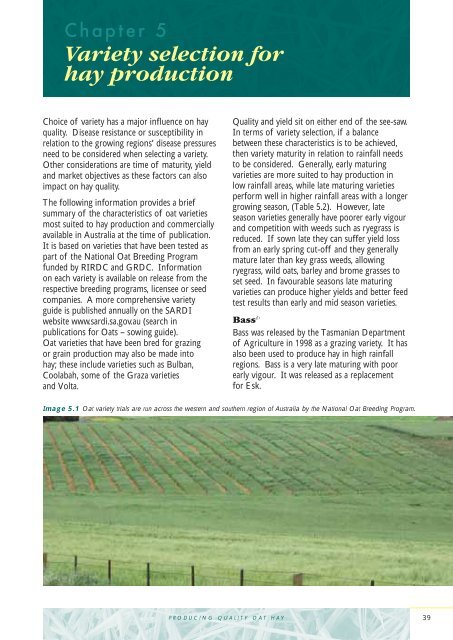You also want an ePaper? Increase the reach of your titles
YUMPU automatically turns print PDFs into web optimized ePapers that Google loves.
Chapter 5<br />
Variety selection for<br />
hay production<br />
Choice of variety has a major influence on hay<br />
quality. Disease resistance or susceptibility in<br />
relation to the growing regions’ disease pressures<br />
need to be considered when selecting a variety.<br />
Other considerations are time of maturity, yield<br />
and market objectives as these factors can also<br />
impact on hay quality.<br />
The following information provides a brief<br />
summary of the characteristics of oat varieties<br />
most suited to hay production and commercially<br />
available in Australia at the time of publication.<br />
It is based on varieties that have been tested as<br />
part of the National <strong>Oat</strong> Breeding Program<br />
funded by RIRDC and GRDC. Information<br />
on each variety is available on release from the<br />
respective breeding programs, licensee or seed<br />
companies. A more comprehensive variety<br />
guide is published annually on the SARDI<br />
website www.sardi.sa.gov.au (search in<br />
publications for <strong>Oat</strong>s – sowing guide).<br />
<strong>Oat</strong> varieties that have been bred for grazing<br />
or grain production may also be made into<br />
hay; these include varieties such as Bulban,<br />
Coolabah, some of the Graza varieties<br />
and Volta.<br />
PRODUCING QUALITY OAT HAY<br />
<strong>Quality</strong> and yield sit on either end of the see-saw.<br />
In terms of variety selection, if a balance<br />
between these characteristics is to be achieved,<br />
then variety maturity in relation to rainfall needs<br />
to be considered. Generally, early maturing<br />
varieties are more suited to hay production in<br />
low rainfall areas, while late maturing varieties<br />
perform well in higher rainfall areas with a longer<br />
growing season, (Table 5.2). However, late<br />
season varieties generally have poorer early vigour<br />
and competition with weeds such as ryegrass is<br />
reduced. If sown late they can suffer yield loss<br />
from an early spring cut-off and they generally<br />
mature later than key grass weeds, allowing<br />
ryegrass, wild oats, barley and brome grasses to<br />
set seed. In favourable seasons late maturing<br />
varieties can produce higher yields and better feed<br />
test results than early and mid season varieties.<br />
Bass A<br />
Bass was released by the Tasmanian Department<br />
of Agriculture in 1998 as a grazing variety. It has<br />
also been used to produce hay in high rainfall<br />
regions. Bass is a very late maturing with poor<br />
early vigour. It was released as a replacement<br />
for Esk.<br />
Image 5.1 <strong>Oat</strong> variety trials are run across the western and southern region of Australia by the National <strong>Oat</strong> Breeding Program.<br />
39

















